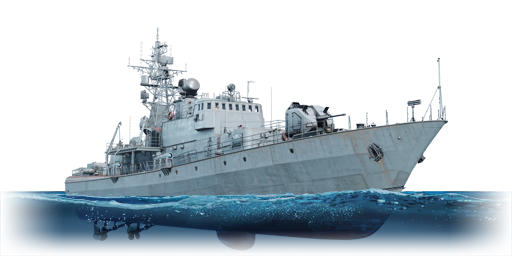



During the mid 1970s, the Soviet Navy saw the need for a new anti-submarine corvette for patrolling the Black sea. The resulting vessel from Project 12412 was named the "Molniya-2", or per its NATO reporting name, the Pauk class. Unlike the pre-production prototype, the serial production Pr.12412 has slightly weaker (but more reliable) engines, having replaced the M-507A diesel engines from the original Tarantul class with the new M-521-TM5 engines with almost 1,000 horsepower less each. The Molniya-2 saw a production span from 1977 to 1989, when it was built for multiple branches of the Soviet forces (namely the Navy and the Coast Guard), along with multiple export customers around the world including Cuba, India, and Bulgaria. After the fall of the USSR, the Monlyia-2s in Soviet service were passed on to successor states, namely the Ukrainian and Russian navy. As of 2022, at least one Pr.12412 is still in active service with each of these countries.
Introduced in Update "Hot Tracks", the MPK Pr.12412 bolsters an already incredible line-up of coastal vessels at that rank of the Soviet tech tree. Joining the likes of other formidable vessels of similar tonnage such as its GE premium sister MPK Pr.12412P and the powerful SKR-7, the "Molnyia-2" brings more to the table than some of its contemporaries at this battle rating, as it has access to a rapid firing autoloaded 76 mm turret with access to two kinds of HE shells, including a HE-VT proximity-fuse shell for dealing with aerial targets (with the help of its radar-aided fire control system), along with a fearsome rotary AK-630 CIWS in the rear for dealing with closer and lower flying targets by filling the air with lead at 5,000 RPM. The diverse armament does not end there, as the Pr.12412 also has access to mortars, depth chargers, and decent torpedoes all at once, making it a true "jack of all trades, yet master of none" for its class. One must be cautious when playing the Pr.12412 due to its sub-par armour (which becomes even more useless when uptiered to face bluewater destroyers), and to not be too trigger happy with the AK-630 CIWS due to its tendency to jam under sustained fire, and its insane rate of fire depleting ammo supplies very quickly when left unchecked.
| Ammunition | Type | Armor penetration (mm) at a distance: | |||||
|---|---|---|---|---|---|---|---|
| 10 m | 100 m | 500 m | 1000 m | 1500 m | 2000 m | ||
| HE | 10 | 10 | 10 | 10 | 10 | 10 | |
| HE-VT | 11 | 11 | 11 | 11 | 11 | 11 | |
| Belt | Belt filling | Armor penetration (mm) at a distance: | |||||
|---|---|---|---|---|---|---|---|
| 10 m | 100 m | 500 m | 1000 m | 1500 m | 2000 m | ||
| HEF-T/HEF-I/HEF-I/HEF-I/HEF-I/HEF-I | 4 | 4 | 4 | 4 | 4 | 4 | |
4 × 400 mm SET-40 torpedo
12 × BB-1 depth charge
12 × BB-1 depth charge
4 × 400 mm SET-40 torpedo
12 × BB-1 depth charge











Seakeeping |
|---|
Unsinkability | |
|---|---|
Firepower | ||
|---|---|---|